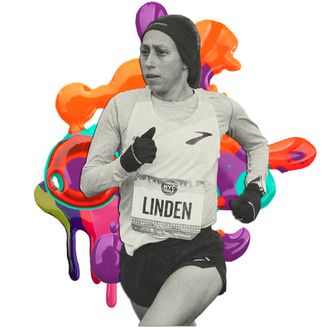
If there’s a single image that represents the gritty determination of distance running, it’s that of two-time Olympian Desiree Linden breaking the tape at the 2018 Boston Marathon, gloved hands open to the sky as rain pours down around her. Her victory marked the first time an American woman won the race since 1985, and it catapulted the wry, resilient athlete, who goes by Des, from a fan favorite in a niche sport into a new level of stardom.
Linden’s longtime motto is “Keep showing up,” and she has remained a consistent competitor since her historic win. She set the women’s masters record — for runners 40 and older — at the 2023 Chicago Marathon (a record since broken by fellow 40-year-old Sara Hall). In February, she competed in her fifth Olympic-marathon trials, placing 11th. Over the weekend, she lined up for the ninth time at the United Airlines NYC Half, one of 60 races staged each year by the nonprofit New York Road Runners. And next month, she’ll return to race Boston for the 11th time.
These days, it isn’t just Linden’s feet doing the talking. She published a best-selling memoir, Choosing to Run, last year that chronicled the highs and lows of her career, including tension with her now-former coaches and a health crisis that had her doubting she would even start, let alone win, Boston in 2018. She also does television commentary for road races and track meets, and in January 2023, she and fellow Olympic marathoner Kara Goucher launched a podcast, Nobody Asked Us. Despite competing for years, the two hadn’t talked much before. “On paper, we were kind of pitted against each other at times,” Linden says. “We’re like, ‘Let’s just start it and see what happens. We might totally hate each other.’” Instead, their chemistry, humor, and insider perspective on running have made the show a hit, even in a sports-media landscape dominated by men discussing the NBA and NFL.
Linden lives in Charlevoix, Michigan, with her husband, Ryan, who’s a marathoner turned triathlete, and two dogs: Rivers, a Chesapeake Bay retriever, and a golden retriever appropriately named Boston. Here, how she gets it done.
On her morning routine:
Sleep is super-important for recovery, particularly at my age. I have a flexible schedule, so I get up when I get up. Usually it’s around seven or so. I have breakfast, usually a bagel with peanut butter — something simple — and definitely coffee. Then I just move around a bit until I feel like I’m ready to run and the conditions are good — often around 10 a.m. I don’t like to feel like I’m fitting the run in. I go when I’m ready to go and enjoy the run and get the most out of it.
On a typical week of marathon training:
I’ll do two harder sessions during the week — longer stuff, a total of 16 to 18 miles. One might be marathon pace–focused. A second session would be going a little bit quicker and running some shorter reps, just making sure I’m turning over the legs and getting comfortable moving faster than marathon pace so marathon pace seems easier. And then I do a classic Sunday long run, sometimes with some faster segments. In between those hard sessions, I’ll do two or three recovery days with easy runs of about 12 miles.
On adapting training over time:
A lot of times, we can get into the same routine and be like, Okay, this is the formula. This is what works. As you age, you have to make adjustments. Sometimes it’s more; sometimes it’s less. I listen to my body and communicate a lot with my coach. It’s like, How do we feel during this? Do we need to do this much?
At this point in my career, I don’t have to do as much mileage. I’ve put a lot in the bank already. Instead, it’s about spending more time on things that will slip as you age. You start to lose power, so how can we increase that? That’s shorter workouts or hitting the gym. So it’s just about being efficient with my time and making sure — it’s such a cliché, but — I’m using it to work smarter, not harder.
On managing stress:
It’s a pretty low-stress life in northern Michigan. Easy, simple living. Getting out on the water: Stand-up paddling, kayaking — things like that in the summer are great. We also added a sauna to the backyard. In the winter, there’s something about going and being warm and reminding yourself how to sweat. We have it lined up so that it’s got a great view of the lake.
On her canine training partners:
Dogs offer perspective. You come back from a good day or a bad day, they’re just happy little fellas. They also need a ton of exercise. Rivers is a pup, so he shouldn’t be running too much, but he’s got a lot of energy and goes up to four miles. Boston goes up to 12 miles and then he also has the luxury of going into the lake, so he runs and swims. They don’t care if it’s pissing rain or feels like two degrees; they’re ready to go, and they’re excited about it. That reminds you of that joy in the run.
On winding down:
Ryan will finish up working and we’ll watch TV together and cook together. Occasionally we’ll go out and have dinner with friends. Getting off work phones and computers and just engaging with each other or other people is very helpful. Sometimes we watch a TV show or read a book, although I haven’t picked up a book in a while. I’ve been on a puzzle kick, so I’ve been doing that in the evenings.
On the moment she felt she’d “made it”:
Boston in 2011, when I came in second place by two seconds, was a big day for me. I had the self-belief that I could compete at the front, and I finally got on the stage and proved it.
On her least favorite part of the job:
The funny part is that the better you get at the craft, the further along in your career you get, the more you’re pulled away from actually doing the craft. A lot of things pull me away from training. Balancing travel and appearances and meet and greets before races and sponsor obligations — that stuff isn’t what you think about when you sign up for professional running. You think, I’m just going to go and train all day and sleep and watch Netflix.
On finding her voice in the sport:
I’m a quiet, introverted person, but through the years I’ve learned that doesn’t get you what you need or what you want. It also doesn’t promote the sport or build up other athletes or your own quote, unquote personal brand. Throughout time, I’ve taken more risks: 2011 was a little step forward in visibility for me and then the Olympic teams are another chance to practice being in front of cameras and engaging with fans. Now it’s more comfortable and I realize the upside.
On encouraging the competition, even mid-race:
There have definitely been folks who encouraged me along the way as I was an up-and-comer: People like Magdalena Lewy-Boulet, Deena Kastor, and Blake Russell. They were competitors, but they were very willing to give me advice, and it helped a lot in my career. The marathon is just a beast. It’s such a hard thing to do, and there’s so much respect for anybody who’s put in all that work and is on the course. You’re fighting against not just your competitors but also the distance.
I know what all those things are like, so if I can give an encouraging word or a little bit of advice to help someone manage the moment, it doesn’t take anything away from me. I want to beat people who are at their absolute best. And if you can’t beat them, you can still celebrate that you’ve managed the distance, the event, and all the hard things that come with it.
On dealing with self-doubt:
Self-doubt is a natural part of life and sport in general, particularly in the marathon. It’s such a daunting event when you’re coming up from 5K, 10K, or even getting to the half-marathon. So much of it was like, Can I cover the distance? Am I made for this sport? Those things were all questions for me.
I learned from experience and failures. If you’re pushing your limits and trying to reach a high level, you’re going to fall short a few times. You can learn from the setbacks. Maybe they’re realistic doubts to begin with and then you realize those doubts can become questions and opportunities to learn. And all of a sudden, that becomes advantageous.
On one of those educational failures:
The 2008 Olympic Trials was my second marathon. I was probably overly confident, but I had great training, and I was like, I’m gonna make the Olympic team. Instead, I hit the wall. It was pivotal because it could have been like, I would never do this again. This was miserable. I feel silly for having that self-belief, and I wasn’t even close to my mark. But to me, it was like, Oh, this is an incredibly challenging puzzle, and I want to get it right. I want to figure this out.
On ambition and future goals:
At this point with running itself, my goal is having the most fun, which probably doesn’t sound very ambitious. I think I’d like to chase the masters record again. There’s some ultra stuff that I still would like to do and do very well. But my goals and ambitions now are more about advising younger athletes, growing the sport, and leaving it a little bit better. That means more opportunities, bigger platforms, and more sponsorship dollars to go around, making it all easier to navigate. I want more athletes to be able to compete for a long time and tap into that patience — and not have to go broke doing it.
On the people who help her get it done:
You gotta thank the sponsors, including Brooks, for supporting the dream. Beyond that, Ryan understands and appreciates the lifestyle and helps a ton. My coach, Walt Drenth, communicates with me and makes sure I’m getting the most out of these last few years of running at a high level. My agent, Josh Cox, manages all the things that I don’t even know about, which is great — that means he’s doing his job. And then there are people I’ve met along the way who are supportive, whether they work for races or are in the media. You can’t call them all out, but they contribute in a way that makes the job a lot of fun.
This interview has been edited and condensed for length and clarity.




